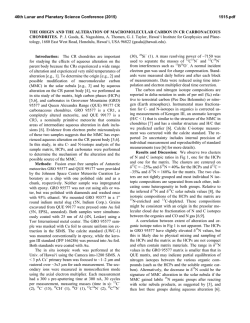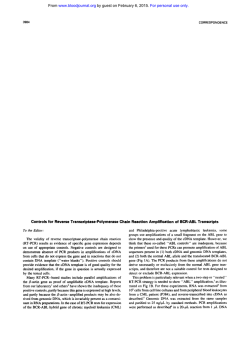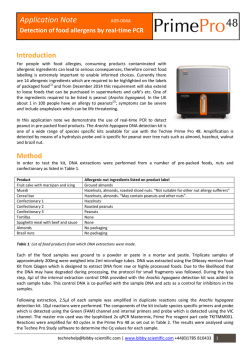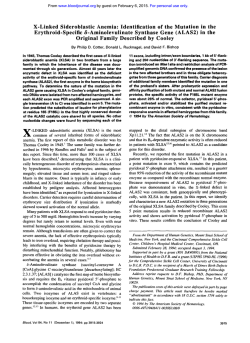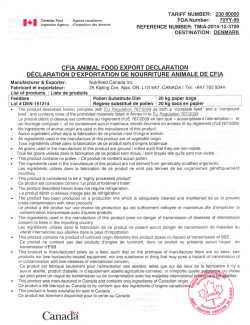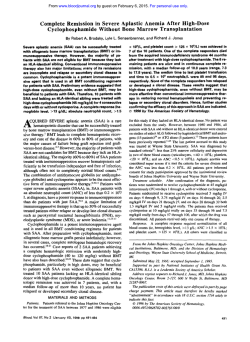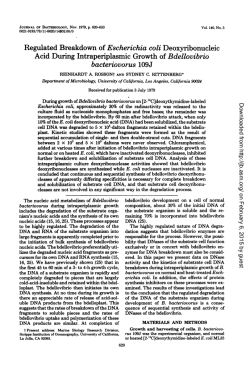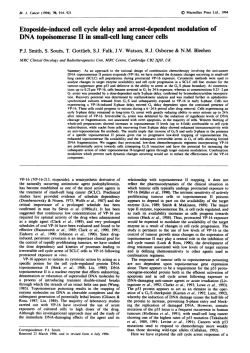
Mitomycin C–Induced DNA Damage in Fanconi
From www.bloodjournal.org by guest on February 6, 2015. For personal use only. 1116 mune neutropenia due to anti-SH. 5th European Symposium on Platelet and Granulocyte Immunobiology, S’Agaro´, Girona, Spain, May 9-12, 1998, p 52 (abstr) 6. Hessner MJ, Curtis BR, Endean DJ, Aster RH: Determination of neutrophil antigen NA gene frequencies in five different ethnic groups CORRESPONDENCE by the polymerase chain reaction with sequence-specific primers (PCR-SSP). Transfusion 36:895, 1996 7. Lin M, Chen CC, Wang CL, Lee HL: Frequencies of neutrophilspecific antigens among Chinese in Taiwan. Vox Sang 66:247, 1994 (letter) Mitomycin C–Induced DNA Damage in Fanconi Anemia: Cross-Linking or Redox-Mediated Effects? To the Editor: The article by Carreau et al1 reports on the in vivo effects of mitomycin C (MMC) in mice carrying the Fanconi anemia (FA) group C mutation (Fac2/2). Among the mechanistic scenarios underlying FA pathogenesis, the authors refer to a phenotypic feature of FA cells related to oxygen hypersensitivity. Unfortunately, the use of citations on this subject appears to be quite inappropriate. First, the authors attributed a ‘‘secondary’’ role for oxygen sensitivity in FA cells2 which, however, may have been made oxygen-resistant after the immortalization procedure. In fact, the loss of O2 sensitivity in transformed cells has been recognized as a general phenomenon, not confined to FA cell lines.3 A general statement was then made1 about the published results of studies which ‘‘have demonstrated overproduction of reactive oxygen species (ROS) and increased susceptibility to oxygen, as well as an increase in ROS-induced DNA lesions, particularly 8-hydroxy-28deoxyguanosine (8OHdG).’’ Unfortunately, the three references reported4-6 (cited as 37-39 in the report) neither dealt with FA nor with ROS-induced DNA damage. The above statement about excess ROS production and 8OHdG formation in FA was true, but rather should refer to the reports by Takeuchi and Morimoto7 and Degan et al.8 It is worthwhile to consider the subject of oxidative stress in FA based on both in vitro and ex vivo evidence, as reviewed by us recently.9 A role for oxidative stress in FA has been documented for two decades, with reports providing evidence for an improvement of either chromosomal instability or cell growth after exposure of either primary lymphocyte cultures or fibroblasts from FA patients to: (1) catalase or superoxide dismutase, (2) low-molecular-weight antioxidants, or (3) decreased oxygen levels.10-14 A G2 cell cycle delay, observed in FA cells, was counteracted by culturing cells in 5% O2,15 and a major role was suggested for free iron in inducing G2 arrest in FA cells.16 The report by Takeuchi and Morimoto7 provided evidence for excess oxidative DNA damage (8OHdG) in FAA cells challenged with H2O2 that was related, at least in part, to catalase deficiency. A recent report by Ruppitsch et al17 provided elegant evidence for the loss of both MMC and diepoxybutane (DEB) sensitivity of FAA cells transfected with cDNA causing overexpression of thioredoxin, a nonenzymatic antioxidant protein.18 Hence, both exogenous and endogenous antioxidants can decrease the phenotypic defect of FA cells, both including O2 and MMC sensitivity. In turn, the action mechanisms of MMC can either be ascribed to DNA cross-linking or to redox cycling, as reported in early studies of MMC.19,20 That MMC sensitivity in FA cells may be attributed to redox mechanisms rather than to DNA cross-linking has been shown by four independent reports11,13,21,22 focused on as many different endpoints (chromosomal instability, cytotoxicity, apoptosis, and mutagenesis). Together, the results of these studies showed that: (1) MMC-induced toxicity was confined to normoxic conditions which, unlike hypoxia, were associated to enhanced redox-cycling mechanisms, not to DNA cross-linking,21,22 and (2) MMC toxicity was both removed by antioxidant enzymes and by low-molecular-weight antioxidants.11,13 The observation of redox abnormalities in FA is not confined to in vitro conditions. A series of ex vivo studies provided evidence for abnormal O2 metabolism in FA patients and in their parents. Freshly drawn white blood cells from both FA homozygotes and heterozygotes produced excess ROS as detected by luminol-dependent chemilumines- cence (LDCL),23,24 and displayed excess 8OHdG levels that were significantly correlated with LDCL as well as with chromosomal instability.8 Thus, both ex vivo and in vitro evidence pointed to a direct link between ROS formation, oxidative DNA damage, and chromosomal breakages in FA. Based on the available evidence, one might suggest that the authors1 could carry out a new series of experiments by exposing Fac2/2 mice to different oxygen levels, with or without MMC administration. As additional endpoints worth being evaluated in Fac2/2 mice, one might suggest to include the evaluation of oxidative DNA damage as well as of ROS-detoxyfying activities. This study could provide a formidable insight both into the FAC defect and the in vivo action mechanisms of MMC. In conclusion, the current view attributing the FA-associated defect(s) to the phenotypic sensitivity to MMC and DEB related to cross-linking mechanisms may be viewed as a fading dogma relying on the definition of FA as a DNA repair disorder. While no conclusive evidence has thus far related FA gene products to any function in DNA repair, a thriving body of evidence has associated MMC (and DEB) sensitivity to an impairment of redox balance in FA cells, both in vitro and in vivo. This evidence should no longer be disregarded in the forthcoming studies of FA. Giovanni Pagano Italian National Cancer Institute G. Pascale Foundation Naples, Italy Adriana Zatterale Cytogenetics Unit, Elena D’Aosta Hospital Naples, Italy Ludmila G, Korkina Russian Institute of Pediatric Hematology Moscow, Russia REFERENCES 1. Carreau M, Gan OI, Liu L, Doedens M, McKerlie C, Dick JE, Buchwald M: Bone marrow failure in the Fanconi anemia group C mouse model after DNA damage. Blood 91:2737, 1998 2. Joenje H, Youssoufian H, Kruyt FAE, dos Santos C, Wevrick R, Buchwald M: Expression of the Fanconi anemia gene FAC in human cell lines: Lack of effect of oxygen tension. Blood Cells Mol Dis 21:182, 1995 3. Saito H, Hammond AT, Moses RE: The effect of low oxygen tension on the in vitro replicative life span of human diploid fibroblast cells and their transformed derivatives. Exp Cell Res 217:272, 1995 4. Nakayama K, Nakayama KI, Negishi I, Kuida K, Sawa H, Loh DY: Targeted disruption of Bcl-2ab in mice: Occurrence of gray hair, polycystic kidney disease, and lymphocytopenia. Proc Natl Acad Sci USA 91:3700, 1994 5. Veis DJ, Sorenson CM, Shutter JR, Korsmeyer SJ: Bcl-2-deficient mice demonstrate fulminant lymphoid apoptosis, polycystic kidneys, and hypopigmented hair. Cell 75:229, 1993 6. Motoyama N, Wang F, Roth KA, Sawa H, Nakayama KI, Nakayama K, Negishi I, Senju S, Zhang Q, Fujii S, Loh DY: Massive cell death of immature hematopoietic cells and neurons in Bcl-xdeficient mice. Science 267:1506, 1995 From www.bloodjournal.org by guest on February 6, 2015. For personal use only. CORRESPONDENCE 1117 7. Takeuchi T, Morimoto K: Increased formation of 8-hydroxydeoxyguanosine, an oxidative DNA damage, in lymphoblasts from Fanconi’s anemia patients due to possible catalase deficiency. Carcinogenesis 14:1115, 1993 8. Degan P, Bonassi S, De Caterina M, Korkina LG, Pinto L, Scopacasa F, Zatterale A, Calzone R, Pagano G: In vivo accumulation of 8-hydroxy-28-deoxyguanosine in DNA correlates with release of reactive oxygen species in Fanconi’s anaemia families. Carcinogenesis 16:735, 1995 9. Pagano G, Korkina LG, Brunk UT, Chessa L, Degan P, Del Principe D, Kelly FJ, Malorni W, Pallardo´ F, Pasquier C, Scovassi I, Zatterale A, Franceschi C: Congenital disorders sharing oxidative stress and cancer proneness as phenotypic hallmarks: Prospects for joint research in pharmacology. Med Hyp 51:253, 1998 10. Nordenson I: Effect of superoxide dismutase and catalase on spontaneously occuring chromosome breaks in patients with Fanconi’s anemia. Hereditas 86:147, 1977 11. Raj AS, Heddle JA: The effect of superoxide dismutase, catalase and L-cysteine on spontaneous and on mitomycin C induced chromosomal breakage in Fanconi’s anemia and normal fibroblasts as measured by the micronucleus method. Mutat Res 78:59, 1980 12. Joenje H, Arwert F, Eriksson AW, de Koning H, Oostra AB: Oxygen-dependence of chromosomal aberrations in Fanconi’s anaemia. Nature 290:142, 1981 13. Nagasawa H, Little JB: Suppression of cytotoxic effect of mitomycin-C by superoxide dismutase in Fanconi’s anemia and dyskeratosis congenita fibroblasts. Carcinogenesis 4:795, 1983 14. Dallapiccola B, Porfirio B, Mokini V, Alimena G, Isacchi G, Gandini E: Effect of oxidants and antioxidants on chromosomal breakage in Fanconi’s anemia lymphocytes. Hum Genet 69:62, 1985 15. Schindler D, Hoehn H: Fanconi anemia mutation causes cellular susceptibility to ambient oxygen. Am J Hum Genet 43:429, 1988 16. Poot M, Gross O, Epe B, Pflaum M, Hoehn H: Cell cycle defect in connection with oxygen and iron sensitivity in Fanconi anemia lymphoblastoid cells. Exp Cell Res 222:262, 1996 17. Ruppitsch W, Meisslitzer C, Hirsch-Kauffmann M, Schweiger M: Overexpression of thioredoxin in Fanconi anemia fibroblasts prevents the cytotoxic and DNA damaging effect of mitomycin C and diepoxybutane. FEBS Lett 422:99, 1998 18. Kuge S, Jones N: YAP1-dependent activation of TRX2 is essential for the response of Saccharomyces cerevisiae to oxidative stress by hydroperoxides. EMBO J 13:655, 1994 19. Gutteridge JMC, Quinlan GJ, Wilkins S: Mitomycin C-induced deoxyribose degradation inhibited by superoxide dismutase. A reaction involving iron, hydroxyl and semiquinone radicals. FEBS Lett 167:37, 1984 20. Pritsos CA, Sartorelli AC: Generation of reactive oxygen radicals through bioactivation of mitomycin antibiotics. Cancer Res 46: 3528, 1986 21. Clarke AA, Philpott NJ, Gordon-Smith EC, Rutherford TR: The sensitivity of Fanconi anaemia group C cells to apoptosis induced by mitomycin C is due to oxygen radical generation, not DNA crosslinking. Br J Haematol 96:240, 1997 22. Liebetrau W, Runger TM, Mehling BE, Poot M, Hoehn H: Mutagenic activity of ambient oxygen and mitomycin C in Fanconi’s anaemia cells. Mutagenesis 12:69, 1997 23. Rumyantsev AG, Samochatova EV, Afanas’ev IB, Korkina LG, Suslova TB, Cheremisina ZP, Maschan AA, Durnev AD, Lurye BL: The role of free oxygen radicals in the pathogenesis of Fanconi’s anemia. Ter Arkh 61:32, 1989 24. Korkina LG, Samochatova EV, Maschan AA, Suslova TB, Cheremisina ZP, Afanas’ev IB: Release of active oxygen radicals by leukocytes of Fanconi’s anemia patients. J Leukoc Biol 52:357, 1992 Response First regarding the references, we believe that one reference by Takeuchi et al1 was omitted due to formatting of the paper and was overlooked on our part. The references cited as 37-39 regard the Bcl2 knockout mice and are discussed and referred to later in the paper. Second, our paper dealt with mitomycin C (MMC) hypersensitivity of the Fancc2/2 mouse model we generated. We believe that our discussion is in fact an overview of the possible in vivo effects of MMC,and we did not dismiss oxygen radical formation as a possible effect during the metabolism of MMC. Nonetheless, one still does not know if reactive oxygen species (ROS) formation is responsible for the hypersensitivity of the Fancc2/2 mice treated with MMC, although we believe that the effect we observed may result from a defect in DNA repair. In fact, more information is now becoming available regarding a DNA repair defect in FA. 1. FA cells were shown to be specifically sensitive to interstrand crosslinks and not intrastrand crosslinks confirming the specificity of the defect in crosslink repair.2 2. FA cells were shown to lack a repair complex that specifically binds DNA crosslinks.3 3. The increased ROS-induced lesion 8OHdG, in FA patients cells also supports the idea of a lack of a repair mechanism; without repair, the lesions remain in the DNA. 4. FANCA and FANCC have been shown to interact in a complex and translocate to the nucleus; this implies a more direct role of FANCC in repair.4 5. FA cells have been shown to be defective in double-strand break repair.5 Oxidative DNA damage is repaired by the BER pathway, which may share steps with the crosslink repair pathway. Thus, increased sensitiv- ity of FA cells to MMC caused by either oxidative damage or crosslinks, or both, support the notion of an altered repair mechanism. We did, however, discuss the possible effect of ROS formation in the toxicity of MMC. Although MMC is known to induce a wide variety of lesions in the DNA, several papers have described the inability of FA cells to repair crosslinked DNA as the principal cause of MMC sensitivity. Again, we do not dismiss ROS formation as a possible mechanism in the toxicity of MMC in the Fancc2/2 mice, and we would be more than willing to provide Dr Pagano with the Fancc 2/2 mice if he wishes to test his hypothesis. Until we find the true function of the FA proteins, one can only speculate on the defects present in FA cells. Madeleine Carreau Manuel Buchwald Program in Genetics and Genomic Biology Research Institute Hospital for Sick Children Toronto, Ontario, Canada REFERENCES 1. Takeuchi T, Morimoto K: Increased formation of 8-hydroxydeoxyguanosine, an oxidative DNA damage, in lymphoblasts from Fanconi’s anemia patients due to possible catalase deficiency. Carcinogenesis 14:1115, 1993 2. Fujiwara Y, Nakamura M, Yokoo S: A new anticancer platinum compound, (2)-(R)-2-aminomethyl-pyrrolidine(1,1-cyclobutanedicar- From www.bloodjournal.org by guest on February 6, 2015. For personal use only. 1118 boxylato) platinum(II): DNA interstrand crosslinking, repair and lethal effects in normal human, Fanconi’s anaemia and xeroderma pigmentosum cells. Br J Cancer 67:1285, 1993 3. Hang B, Yeung AT, Lambert MW: A damage-recognition protein which binds to DNA containing interstrand cross-links is absent or defective in Fanconi anemia, complementation group A cells. Nuclic Acids Res 21:4187, 1993 CORRESPONDENCE 4. Yamashita T, Kupfer G, Naf D, Suliman A, Joenje H, Asano S, D’Andrea AD: The Fanconi anemia pathway requires FAA phosphorylation and FAA/FAC nuclear accumulation. Proc Natl Acad Sci USA 95:13085, 1998 5. Escarceller M, Buchwald M, Singleton B, Jeggo P, Jackson S, Moustacchi E, Papadopoulo D: Fanconi anemia C gene product plays a role in the fidelity of blunt DNA end-joining. J Mol Biol 279:375, 1998 Is the Oral Methionine Loading Test Insensitive to the Remethylation Pathway of Homocysteine? To the Editor: Methylenetetrahydrofolate reductase (MTHFR) is a key enzyme in the remethylation pathway of homocysteine. The study by Girelli et al1 showed that the C677T mutation of the gene encoding for MTHFR is common in Italy, is not associated with coronary atherosclerotic disease, and influences the plasma levels of total homocysteine (tHcy) only in subjects who have low serum concentrations of folic acid. These findings are important confirmations of previous reports.2-6 In addition to the above issues, Girelli and his coworkers addressed the problem of the influence of the MTHFR genotype on the increases of plasma tHcy levels after an oral methionine loading. The methionine loading test, which was originally developed to detect heterozygosity for the deficiency of cystathionine-b-synthase, a key enzyme in the transsulfuration pathway of homocysteine,7 is useful not only to detect subjects with defects of the trans-sulfuration pathway, but also to identify subjects at risk for thrombosis.8,9 It has been suggested that abnormal post-methionine loading (PML) increases in the plasma levelsof tHcy reflect abnormalities of the trans-sulfuration pathway of homocysteine metabolism and are insensitive to the remethylation pathway, in contrast with fasting plasma levels of tHcy, which are sensitive to the remethylation pathway.10,11 If this hypothesis were true, the T/T mutation at nucleotide 677 of MTHFR, which is associated with an enzyme activity of about 50% of normal, should not influence the results of the methionine loading test. Girelli et al commented that their results agree with this hypothesis, because they showed that homozygosity for the C677Tmutation of MTHFR is not associated with abnormally high PML tHcy increments.1 However, they found higher PML tHcy increments in individuals carrying the mutant T/T genotype (25.5 µmol/L) than in those with normal (C/C) or heterozygous (C/T) genotypes (23.6 µmol/L for both), although the difference was not statistically significant (Table 1). In addition, they found that individuals with low serum levels of folate, which plays an important role in the remethylation pathway, tended to have higher PML tHcy increments than those with high folate levels, independently of their genotype (24.9 v 22.9 for C/C; 25.1 v 23.5 for C/T; 28.8 v 21.4 for T/T). In our opinion, these data do not allow a definite conclusion regarding the influence of defects of the remethylation pathway on the methionine loading test. At least four additional reports with an experimental design similar to that of Girelli et al have been published thus far.2,3,5,6 All of them clearly showed that the fasting tHcy levels in plasma are significantly higher in the T/T genotype of MTHFR than in the other genotypes; however, the results of the methionine loading test were less consistent. Table 1 shows that all the studies, perhaps with the exception of that by Jacques et al,6 showed that the PML increases of tHcy in plasma were higher in the T/T genotype of MTHFR than in the normal C/C genotype, although the statistical significance was reached in only two.2,5 Since the publication of our study in 1997,2 we screened more individuals for MTHFR genotype and the methionine loading test. Our most recent analysis of the data obtained in 399 healthy controls and 250 patients with previous episodes of arterial or venous thrombosis confirmed our previous findings that the PML increases of tHcy levels in plasma are significantly higher in individuals with the T/T genotype (18.2 6 7.5, Table 1. Increases of Plasma tHcy After an Oral Methionine Loading as a Function of MTHFR Genotypes PML tHcy Increase (µmol/L) MTHFR Genotype at nt 677 Study Jacques et al, 19966 † Cattaneo et al, 19972 † Legnani et al, 19973 † Verhoef et al, 19975 ‡ Girelli et al, 19981 ‡ No. of Subjects C/C C/T T/T 365 17.9 18.5 18.2 NS 231 14.4 14.8 18.6 .006 63 17.0 19.0 23.1 NS 318 23.6 26.4 27.7 ,.05 415 23.6 23.6 25.5 NS P* Values of PML tHcy increase are arithmetic means (†) or geometric means (‡). The dose of oral methionine was 3.8 g/m2 body surface area in the study by Cattaneo et al, and 100 mg/kg body weight in the other studies. Abbreviation: NS, not significant. *Genotype T/T v genotype C/C. arithmetic mean 6 SD) than in those with the C/C or the C/T genotypes of MTHFR (14.1 6 5.6, P , .001). The differences remained highly statistically significant (P , .001) also after adjustment for the serum levels of folate and cobalamin, and the plasma levels of vitamin B6, which is the essential cofactor in the trans-sulfuration pathway of homocysteine.5 Among the 649 subjects studied, 142 had the T/T genotype of MTHFR (80 controls and 62 cases); 14 of them (9.9%) had high fasting tHcy levels, 15 (10.6%) had both high fasting levels and high PML increases of tHcy, and 6 (4.2%) had high PML increases of tHcy. Therefore, the methionine loading test allowed the identification of 6 additional subjects with the MTHFR variant who had normal fasting levels of tHcy. In conclusion, the available experimental evidence indicates that the fasting levels of tHcy in plasma are very sensitive to an abnormality of the remethylation pathway of homocysteine, such as that associated with the T/T genotype of MTHFR; however, they do not allow the conclusion that the PML increases of tHcy levels in plasma only reflect abnormalities of the trans-sulfuration pathway of homocysteine, because they also tend to be abnormal in individuals with the T/T genotype of MTHFR and in those with low serum levels of folic acid. Marco Cattaneo Rossana Lombardi Anna Lecchi Maddalena L. Zighetti A. Bianchi Bonomi Hemophilia and Thrombosis Center Department of Internal Medicine IRCCS Ospedale Maggiore University of Milano Milano, Italy From www.bloodjournal.org by guest on February 6, 2015. For personal use only. 1999 93: 1116-1118 Mitomycin C−Induced DNA Damage in Fanconi Anemia: Cross-Linking or Redox-Mediated Effects? Giovanni Pagano, Adriana Zatterale and Ludmila G, Korkina Updated information and services can be found at: http://www.bloodjournal.org/content/93/3/1116.full.html Articles on similar topics can be found in the following Blood collections Information about reproducing this article in parts or in its entirety may be found online at: http://www.bloodjournal.org/site/misc/rights.xhtml#repub_requests Information about ordering reprints may be found online at: http://www.bloodjournal.org/site/misc/rights.xhtml#reprints Information about subscriptions and ASH membership may be found online at: http://www.bloodjournal.org/site/subscriptions/index.xhtml Blood (print ISSN 0006-4971, online ISSN 1528-0020), is published weekly by the American Society of Hematology, 2021 L St, NW, Suite 900, Washington DC 20036. Copyright 2011 by The American Society of Hematology; all rights reserved.
© Copyright 2026



